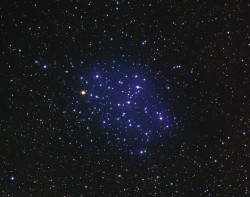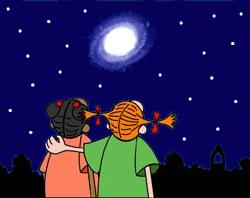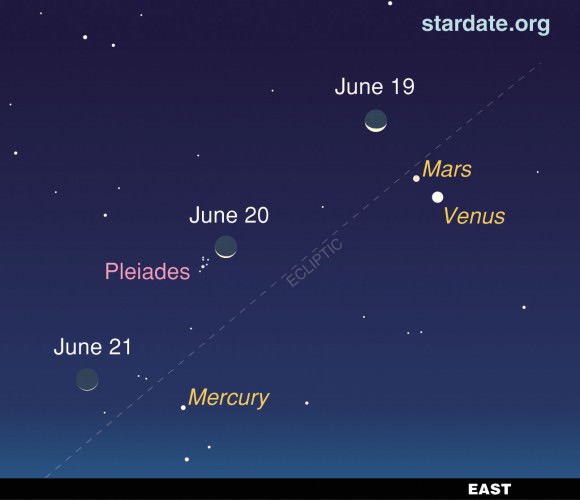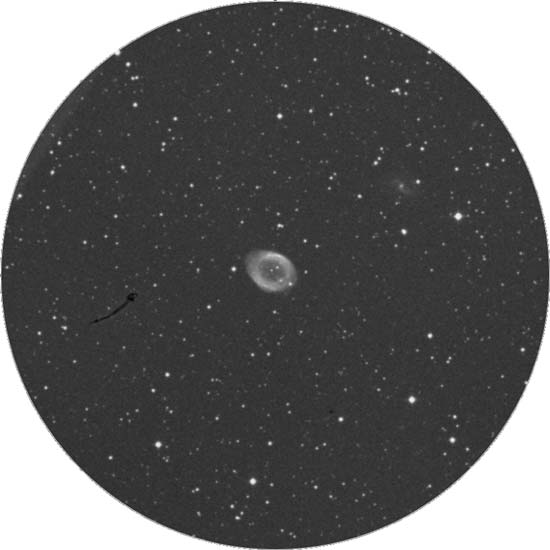Greetings, fellow SkyWatchers! You asked for some excitement? You got it. As it the current planetary line up wasn’t treat enough for the weekend, there’s still lots more to go. With dark skies around, we’ll be taking on some challenging studies like faint objects near bright stars… But we won’t be forgetting to chase “Butterflies”! The Celestial Scenery just keeps getting better as the weekend rolls on with a Saturday morning meteor shower. Why not grab coffee and donuts and make a date to watch? The planetary conjunction continues with a close pass on the Pleiades, too. Join the merry-go-round of stars and grab for the “Ring”! Summer Solstice is upon us and there’s no place I’d rather be than out back with you viewing the stars…
 Friday, June 19, 2009 – This morning, begin by noting the 1846 birth on this date of Italian astronomer, Antonio Abetti. Although his name might seem a bit obscure, what he studied was not—small planets, comets, and star occultations. This morning your mission is to observe one of the nicest alignments you’ll see this year—the Moon, Venus, and Mars. Look for this beautiful trio on the anniversary of Abetti’s birth about a half-hour before dawn!
Friday, June 19, 2009 – This morning, begin by noting the 1846 birth on this date of Italian astronomer, Antonio Abetti. Although his name might seem a bit obscure, what he studied was not—small planets, comets, and star occultations. This morning your mission is to observe one of the nicest alignments you’ll see this year—the Moon, Venus, and Mars. Look for this beautiful trio on the anniversary of Abetti’s birth about a half-hour before dawn!
Ready tonight for a new direction in observing? Then look no further than the tail of the Scorpion, and get ready to head south, then north. The Summer Milky Way is upon us! Let’s start with a ‘‘bright star and globular cluster’’ view. Some of the easiest studies to find are ones residing in the same field as bright, recognizable stars. And, some the most difficult things to observe in the night sky are—you guessed it—faint studies lying near overwhelmingly bright stars! But there are compromises. . .
Less than 30 east of 3.3-magnitude G Scorpii (the tail star of the Scorpion) is 7.4-magnitude globular cluster NGC 6441 (RA 17 50 12 Dec -37 03 03). This 38,000-light-year-distant compact cluster is about 13,000 light-years from the galactic core. It was first noted from southeastern Australia in 1826 by James Dunlop. Around 2.5 degrees northeast of G Scorpii (and NGC 6441) is another interesting deep-sky twosome—bright open cluster M7 and faint globular NGC6453. M7 (RA 17 53 51 Dec -34 47 34) was first recorded as a glowing region of faint stars by Ptolemy, circa 130 BC.
Located 800 light-years away, the cluster includes more than half a dozen 6th magnitude stars. It is easily resolved with the least amount of optical aid, and as many as 80 stars can be seen in a small telescope. Now head northeast, and the faint haze of the 31,000-light-year-distant globular cluster NGC 6453 (RA 17 50 51 Dec -34 35 59) will reveal itself to mid- and large-sized scopes. Like NGC 6441, this globular was discovered from the Southern Hemisphere, in this case by John Herschel on June 8, 1837, while he was observing from the Cape of Good Hope in South Africa.
Saturday, June 20, 2009 – In the predawn hours, we welcome the ‘‘shooting stars’’ as we pass through another portion of the Ophiuchid meteor stream. The radiant for this pass lies nearer Sagittarius, and the fall rate varies from 8 to 20 per hour, but the Ophiuchids can sometimes produce more than expected! But getting up early to watch a meteor shower has even more perks on this date…
 Before day breaks, enjoy the ‘‘Old Moon in the New Moon’s Arm’’ as it heads toward a later occultation of the Pleiades. Look up higher yet and enjoy the fine conjunction of Mars and Venus as they pair together and overhead for the bright visage of Jupiter. Perhaps the sky acknowledges the 1966 passing of Georges Lemaitre on this date? Lemaitre researched cosmic rays and the three-body problem and in 1927 formulated the Big Bang theory using Einstein’s theories.
Before day breaks, enjoy the ‘‘Old Moon in the New Moon’s Arm’’ as it heads toward a later occultation of the Pleiades. Look up higher yet and enjoy the fine conjunction of Mars and Venus as they pair together and overhead for the bright visage of Jupiter. Perhaps the sky acknowledges the 1966 passing of Georges Lemaitre on this date? Lemaitre researched cosmic rays and the three-body problem and in 1927 formulated the Big Bang theory using Einstein’s theories.
Tonight locate Lyra’s southernmost pair of stars—Beta and Gamma—for the Ring Nebula (RA 18 53 35 Dec +33 01 42). Discovered by Antoine Darquier in 1779, the Ring was cataloged later that year by Charles Messier as M57. In binoculars, it appears slightly larger than a star, but cannot be focused to a sharp point. Through a modest telescope, and even at low power, M57 turns into a glowing, elongated donut against a wonderful stellar backdrop. How you see the 1,400 light-year distant ‘‘King of the Rings’’ on any given night is highly subject to conditions. As aperture and power increase, so do details. It’s not impossible to see braiding in the nebula’s structure with scopes as small as 8’’ on a fine night, or to pick up the faint 13th magnitude star caught on the edge in even smaller apertures.
Like many planetary nebulae, seeing the central illuminating star is considered the ultimate in celestial viewing. This ‘‘shy friend’’ is a peculiar blue dwarf, which gives off a continuous spectrum and might be variable. At times, this near 15th magnitude star can be seen with ease through a 12.5’’ telescope, yet remains elusive to 31’’ in aperture a few weeks later. Can you spot faint IC 1296, which floats majestically nearby?
Sunday, June 21, 2009 – Wake up, sleepyheads. The last of the very fine conjunctions is about to end and you don’t want to miss it!
If you’re out before dawn, look for Mercury a little more than 6 degrees south of the Moon. No luck spotting it? Try binoculars. Mercury is only about 3 degrees north of red Aldebaran!
Summer solstice occurs today, but what exactly is it? A solstice is nothing more than an astronomical term for the moment when one hemisphere of Earth is tilted the most toward the Sun. Today, the Sun is about 24 degrees above the celestial equator—its highest point of the year. Summer solstice is also the day of the year with the longest period of daylight—and the shortest of night; this occurs around 6 months from now for the Southern Hemisphere.
 Today is also the anniversary of the 1863 birth of Maximilian Franz Joseph Cornelius Wolf. Wolf used wide-field photography to study the Milky Way, and statistical treatment of star counts to prove the existence of clouds of dark matter. Wolf was one the first to prove spiral nebulae contained star-like spectra, and he introduced photography to help discover hundreds of asteroids!
Today is also the anniversary of the 1863 birth of Maximilian Franz Joseph Cornelius Wolf. Wolf used wide-field photography to study the Milky Way, and statistical treatment of star counts to prove the existence of clouds of dark matter. Wolf was one the first to prove spiral nebulae contained star-like spectra, and he introduced photography to help discover hundreds of asteroids!
 Dark skies continue tonight, and so we’ll continue following the great expanse of the Summer Milky Way. Our first stop will be the Butterfly Cluster—M6 (RA 17 40 20 Dec -32 15 15). About the size of the Full Moon, this scattering of 7–12th magnitude stars looks like its namesake. The ‘‘wings’’ of M6 are easily seen as two lobes east and west of the cluster’s main body. Around 75 blue and blue/white stars are visible at low power.
Dark skies continue tonight, and so we’ll continue following the great expanse of the Summer Milky Way. Our first stop will be the Butterfly Cluster—M6 (RA 17 40 20 Dec -32 15 15). About the size of the Full Moon, this scattering of 7–12th magnitude stars looks like its namesake. The ‘‘wings’’ of M6 are easily seen as two lobes east and west of the cluster’s main body. Around 75 blue and blue/white stars are visible at low power.
Want more? Head northeast a little more than 1 degree to reveal the expansive, 5.5-magnitude open cluster NGC 6383. Continue to sweep west at low power to find what might be expected as a very faint sheen of stars—9th magnitude NGC 6374. What’s that? You can’t find it? Then you’ve just learned an invaluable lesson. Some things in J.L.E. Dreyer’s catalogue simply don’t exist!
But we exist, don’t we fellow SkyWatchers? You betcha’. And what a terrific weekend we had together!
The week’s awesome images are (in order of appearance): Antonio Abetti (historical image), M7 (credit—Burrell Schmidt/NOAO/AURA/NSF), Georges Lemaitre and Albert Einstein (historical image), M57 and IC 1296 (credit—Palomar Observatory, courtesy of Caltech), Max Wolf (historical image) and M6 (credit—Nigel Sharp, Mark Hanna, REU program/NOAO/AURA/NSF). We thank you all so much!




